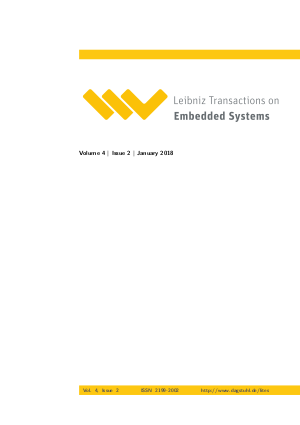Leibniz Transactions on Embedded Systems, Volume 4, Issue 2
LITES, Volume 4, Issue 2
-
Part of:
Volume:
LITES, Volume 4
Journal: Leibniz Transactions on Embedded Systems (LITES)

Publication Details
- published at: 2017-07-07
- Publisher: Schloss Dagstuhl – Leibniz-Zentrum für Informatik
- DBLP: db/journals/lites/lites4
Access Numbers
- Detailed Access Statistics available here
-
Total Document Accesses (updated on a weekly basis):
0PDF Downloads
Documents
LITES, Volume 4, Issue 2
Abstract
Cite as
LITES, Volume 4, Issue 2, Schloss Dagstuhl – Leibniz-Zentrum für Informatik (2017)
Copy BibTex To Clipboard
@Article{LITES-v004-i002,
title = {{LITES, Volume 4, Issue 2}},
journal = {Leibniz Transactions on Embedded Systems},
ISSN = {2199-2002},
year = {2017},
volume = {4},
number = {2},
publisher = {Schloss Dagstuhl -- Leibniz-Zentrum f{\"u}r Informatik},
address = {Dagstuhl, Germany},
URL = {https://drops.dagstuhl.de/entities/document/10.4230/LITES-v004-i002},
doi = {10.4230/LITES-v004-i002},
annote = {Keywords: LITES, Volume 4, Issue 2}
}
Dynamic and Static Task Allocation for Hard Real-Time Video Stream Decoding on NoCs
Abstract
Cite as
Hashan R. Mendis, Neil C. Audsley, and Leandro Soares Indrusiak. Dynamic and Static Task Allocation for Hard Real-Time Video Stream Decoding on NoCs. In LITES, Volume 4, Issue 2 (2017). Leibniz Transactions on Embedded Systems, Volume 4, Issue 2, pp. 01:1-01:25, Schloss Dagstuhl – Leibniz-Zentrum für Informatik (2017)
Copy BibTex To Clipboard
@Article{mendis_et_al:LITES-v004-i002-a001,
author = {Mendis, Hashan R. and Audsley, Neil C. and Indrusiak, Leandro Soares},
title = {{Dynamic and Static Task Allocation for Hard Real-Time Video Stream Decoding on NoCs}},
journal = {Leibniz Transactions on Embedded Systems},
pages = {01:1--01:25},
ISSN = {2199-2002},
year = {2017},
volume = {4},
number = {2},
publisher = {Schloss Dagstuhl -- Leibniz-Zentrum f{\"u}r Informatik},
address = {Dagstuhl, Germany},
URL = {https://drops.dagstuhl.de/entities/document/10.4230/LITES-v004-i002-a001},
URN = {urn:nbn:de:0030-drops-192689},
doi = {10.4230/LITES-v004-i002-a001},
annote = {Keywords: Real-time multimedia, Task mapping, Network-on-chip}
}
EMSBench: Benchmark and Testbed for Reactive Real-Time Systems
Abstract
Cite as
Florian Kluge, Christine Rochange, and Theo Ungerer. EMSBench: Benchmark and Testbed for Reactive Real-Time Systems. In LITES, Volume 4, Issue 2 (2017). Leibniz Transactions on Embedded Systems, Volume 4, Issue 2, pp. 02:1-02:23, Schloss Dagstuhl – Leibniz-Zentrum für Informatik (2017)
Copy BibTex To Clipboard
@Article{kluge_et_al:LITES-v004-i002-a002,
author = {Kluge, Florian and Rochange, Christine and Ungerer, Theo},
title = {{EMSBench: Benchmark and Testbed for Reactive Real-Time Systems}},
journal = {Leibniz Transactions on Embedded Systems},
pages = {02:1--02:23},
ISSN = {2199-2002},
year = {2017},
volume = {4},
number = {2},
publisher = {Schloss Dagstuhl -- Leibniz-Zentrum f{\"u}r Informatik},
address = {Dagstuhl, Germany},
URL = {https://drops.dagstuhl.de/entities/document/10.4230/LITES-v004-i002-a002},
URN = {urn:nbn:de:0030-drops-192698},
doi = {10.4230/LITES-v004-i002-a002},
annote = {Keywords: Real-time benchmark, WCET Analysis, Engine Management System}
}
Per Processor Spin-Based Protocols for Multiprocessor Real-Time Systems
Abstract
Cite as
Sara Afshar, Moris Behnam, Reinder J. Bril, and Thomas Nolte. Per Processor Spin-Based Protocols for Multiprocessor Real-Time Systems. In LITES, Volume 4, Issue 2 (2017). Leibniz Transactions on Embedded Systems, Volume 4, Issue 2, pp. 03:1-03:30, Schloss Dagstuhl – Leibniz-Zentrum für Informatik (2018)
Copy BibTex To Clipboard
@Article{afshar_et_al:LITES-v004-i002-a003,
author = {Afshar, Sara and Behnam, Moris and Bril, Reinder J. and Nolte, Thomas},
title = {{Per Processor Spin-Based Protocols for Multiprocessor Real-Time Systems}},
journal = {Leibniz Transactions on Embedded Systems},
pages = {03:1--03:30},
ISSN = {2199-2002},
year = {2018},
volume = {4},
number = {2},
publisher = {Schloss Dagstuhl -- Leibniz-Zentrum f{\"u}r Informatik},
address = {Dagstuhl, Germany},
URL = {https://drops.dagstuhl.de/entities/document/10.4230/LITES-v004-i002-a003},
URN = {urn:nbn:de:0030-drops-192708},
doi = {10.4230/LITES-v004-i002-a003},
annote = {Keywords: Resource sharing, Real-time systems, Multiprocessors, Spin-locks}
}